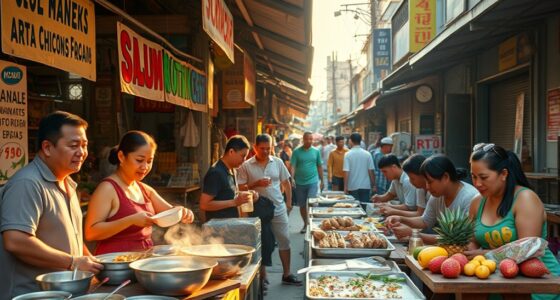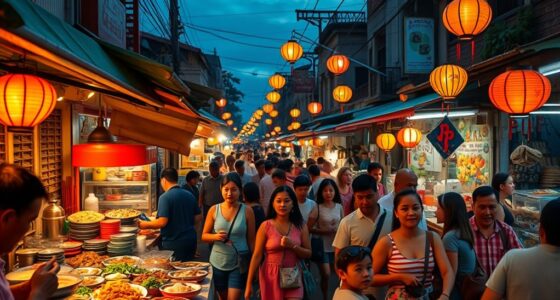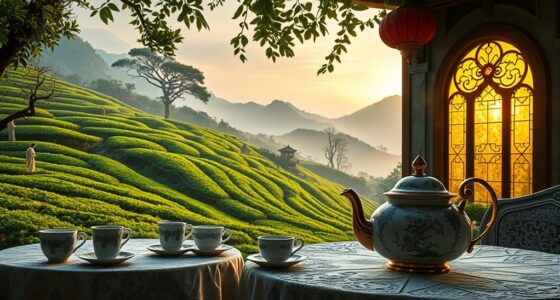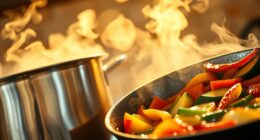France offers iconic vineyard regions like Bordeaux, famous for its blends of Merlot and Cabernet Sauvignon on rolling hills, and Burgundy, renowned for its Pinot Noir and Chardonnay in meticulously cared-for plots. The landscapes and climates shape each wine’s character, making every visit a rich experience. If you explore further, you’ll uncover how regional differences influence taste and style, adding depth to your wine journey and appreciation.
Key Takeaways
- Bordeaux boasts expansive vineyards on rolling hills, producing renowned Merlot and Cabernet Sauvignon wines perfect for vineyard tours.
- Burgundy features smaller, meticulously maintained plots of Pinot Noir and Chardonnay, offering intimate tasting experiences.
- The diverse terroir and climate across French regions influence distinct flavor profiles and wine styles.
- Visiting vineyards in Bordeaux and Burgundy allows wine lovers to explore regional landscapes and winemaking craftsmanship.
- Combining vineyard exploration with expert tasting techniques deepens understanding and appreciation of France’s top wine regions.

Have you ever wondered what makes French wines so renowned worldwide? It’s not just the reputation or tradition; it’s the experience behind each sip. When you visit France’s top vineyard regions, you’ll discover that mastering wine tasting techniques enhances your appreciation. To truly savor what you’re drinking, start by observing the wine’s color and clarity, which reveals details about its age and production. Swirl the glass gently to release its aromas, then take a deep sniff to identify the complex scents—fruits, spices, and earthy notes. Finally, take a small sip, letting the wine coat your palate so you can analyze its texture, acidity, and finish. These wine tasting techniques turn an ordinary tasting into an immersive experience, allowing you to connect deeply with the wine’s story.
Discover French wines by observing color, swirling aromas, and savoring textures for a deeper tasting experience.
Additionally, understanding color accuracy in wine presentation can heighten your sensory experience, as visual cues often influence your perception of taste.
As you explore France’s renowned vineyard regions, keep in mind vineyard tour tips that will enrich your journey. When touring a vineyard, arrive with an open mind and a notebook to jot down impressions. Listen carefully to the guide’s explanations about the terroir—the unique combination of soil, climate, and grape varieties—that influence each wine’s character. Ask questions about the cultivation and harvest process, as this context makes tasting more meaningful. Take your time to walk through the rows of vines, feeling the texture of the soil and observing the health of the plants. These little details add layers of understanding and appreciation.
In regions like Bordeaux or Burgundy, you’ll find that the landscape itself tells a story. In Bordeaux, the expansive vineyards stretch across rolling hills, with blends of grapes like Merlot and Cabernet Sauvignon creating bold, complex wines. Burgundy, by contrast, features smaller, meticulously cared-for plots that produce elegant Pinot Noir and Chardonnay. During your vineyard tour, pay attention to how the terrain and climate influence the grapes’ flavor profiles. Engaging with the winemakers and asking about their techniques can deepen your insights, making each tasting session more meaningful.
Ultimately, the key to enjoying France’s vineyard regions is blending your knowledge of wine tasting techniques with practical vineyard tour tips. This approach transforms a simple visit into a thorough experience, allowing you to appreciate the craftsmanship behind each bottle. Whether you’re sipping a delicate Burgundy or a robust Bordeaux, understanding the process enhances your enjoyment. So, go ahead—embrace the journey, explore the vineyards, and savor every glass with newfound insight and appreciation.
Frequently Asked Questions
What Is the Best Time of Year to Visit French Vineyards?
The best time to visit French vineyards is during the late summer to early fall, around September and October. This period aligns with seasonal harvests, giving you the chance to experience grape picking and wine tastings at their freshest. You’ll also enjoy mild weather considerations, avoiding the winter chill and summer heat. Visiting during this time guarantees you witness the vibrant vineyard atmosphere and savor wines at their peak.
Are Guided Wine Tours Available in All Regions?
While guided wine tours are widely available, not every region offers the same vineyard accessibility. In popular areas like Bordeaux and Burgundy, you’ll find numerous guided tours that deepen your experience. However, some smaller or remote regions may have limited options. You’ll want to research specific regions beforehand, as guided wine tours can enhance your visit, providing insider knowledge and exclusive access that you might not discover on your own.
How Can I Learn About Wine Tasting Techniques?
You can learn about wine tasting techniques by joining guided tastings, where experts demonstrate how to evaluate wine aroma and use a proper tasting glass. Pay attention to the swirl, smell, and sip, noting the wine’s aroma and flavor profile. Practice regularly, and don’t hesitate to ask questions. Watching videos or taking courses online also helps refine your palate and understanding of tasting techniques.
What Local Foods Should I Pair With French Wines?
You should pair French wines with regional cheese and traditional dishes for the best experience. For example, enjoy a glass of Bordeaux with aged Comté or a crisp Chablis alongside oysters. Rich Burgundy wines complement beef bourguignon, while rosé pairs beautifully with Provençal salads. Experiment with local cheeses and regional specialties to enhance your wine-tasting journey, creating harmonious flavors that highlight each area’s unique culinary heritage.
Are Vineyard Visits Suitable for Children or Non-Drinkers?
Vineyard visits can be enjoyable for children and non-drinkers, offering family-friendly activities and non-drinker experiences. Many vineyards provide guided tours, tastings, and workshops that engage all ages, making it a fun outing for everyone. You can explore scenic landscapes, learn about wine production, and participate in grape stomping or picnics. These experiences let you appreciate France’s rich wine culture without drinking, creating memorable moments for the whole family.
Conclusion
As you wander through France’s enchanting vineyard regions, you’re stepping into a tapestry woven with centuries of tradition and passion. Each vineyard tells a story, offering you a taste of history in every sip. So, embrace the adventure, let your senses guide you, and remember—these regions are the heartbeats of France’s wine heritage. Your journey is a story waiting to be written, with each vineyard a chapter in your own unforgettable wine lover’s tale.









